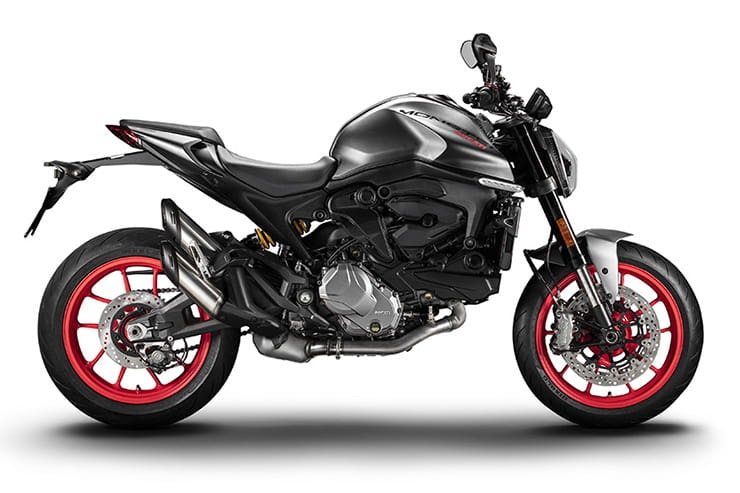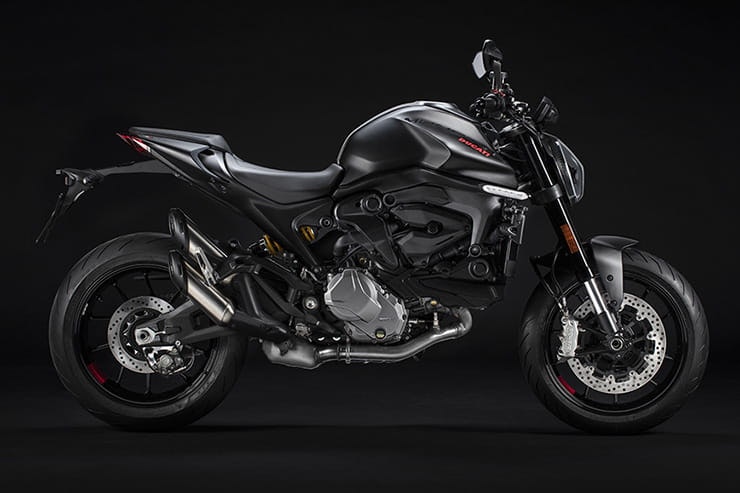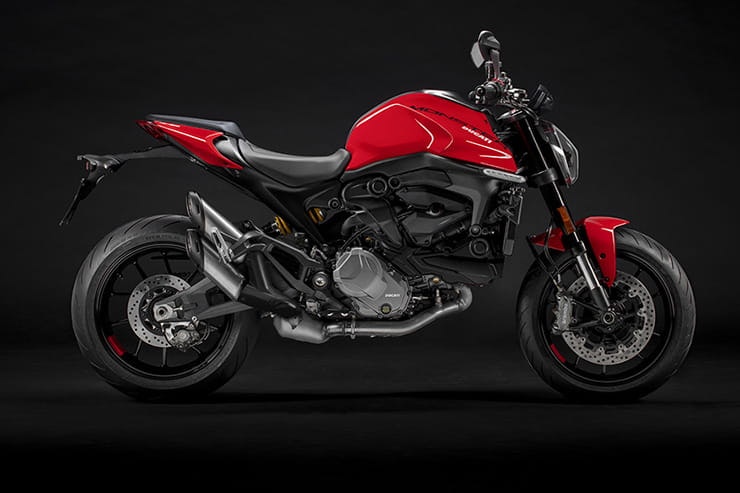New 2021 Ducati Monster – all the specs & details
By Ben Purvis
Motorcycle Journalist
02.12.2020
*UPDATE: read our full Ducati Monster (2021) review here*
For years Ducati’s Monster range has been a minefield of multiple models – air cooled, water-cooled, with capacities ranging from 400cc to 1200 and stopping at virtually every size in between over the years since the original version’s 1993 launch. But for 2021 the model is returning to its roots and simply called ‘Monster’.
In 2020 there were four models in the Monster range – the entry-level, 73hp 797 at £7995, the 109hp 821 at £9995, the 147hp 1200 at £11,995 and the 1200 S at £15,095. But for 2021 it’s a much simpler setup; the bike on offer is the Monster, powered by the same 937cc Testastretta 11° that’s used by the SuperSport, the Multistrada 950 and the Hypermotard 950. It’s bolted to a brand new, Panigale V4-inspired aluminium chassis to become the first Monster to ditch Ducati’s signature trellis frame, and packs 111hp to sit between the old 821 and the 1200 in terms of performance. The price reflects that position, with a starting tag of £10,295.
The engine might be the familiar Testastretta 11°, in Euro5-compliant form for 2021 of course, but the cast aluminium chassis is a huge departure for the Monster, and the benefits are to be found in the bike’s weight – a remarkable 166kg dry, or 188kg complete with all its fluids and a 90% full tank of fuel. That’s 18kg less than the old Monster 821.
The savings are found all over the bike. The 937cc engine is 2.4kg lighter than the 821cc version, the frame – which only attaches the steering head to the engine, using the motor itself as the main rear structure – is 4.5kg lighter than before, weighing a mere 3kg. At the back, Ducati has used glass-fibre reinforced polymer (GFRP) instead of metal for the seat subframe to save another 1.9kg, while the wheels are 1.7kg lighter and the swingarm drops 1.6kg. If there was a Slimmer of the Year award for bikes, it would go to the Monster.
The suspension is typical Ducati fare, with 43mm USD forks and a rear monoshock, but there’s no Ohlins-suspended ‘S’ version on offer at the moment. The brakes are from Brembo, of course, with radial-mount M4-32 calipers and 320mm discs, plus a radial master cylinder and a matching one for the hydraulic clutch.
As well as being lighter, the new bike is smaller than its predecessor. The wheelbase drops from 1480mm to 1474mm and while the seat is higher than before at 820mm, it’s narrow to make it easier to reach the ground. An optional low seat drops the height to 800mm, while a suspension-lowering kit can reduce the stretch further to just 775mm.
The riding position is more upright, with bars moved 70mm nearer the rider and pegs moved down and forwards by 10mm and 35mm respectively, to make the bike easier to handle. The steering angle is one area where the firm isn’t following tradition, as where early Monsters were often criticised for running out of lock too early, the 2021 design’s bars can turn a full 36° in either direction, a substantial 7° more than the 821 could manage.
In terms of styling, there’s only so much that can be done with the Monster’s traditional combination of a seat, tank, headlight and little else, so the 2021 bike is instantly recognisable. However, that new aluminium frame is a clear departure in appearance as well as tech, and the new LED headlight gives a more modern look than before. A sharp tail with body-coloured side panels means this new design has a bit more plastic than its forefathers, too. The hump-backed tank is a clear throwback to the Monsters of yore (Ducati calls its shape ‘Bison-backed’) but now has strip-shaped indicators melded into its leading edges. They’re made with multiple LEDs that light sequentially rather than simply flashing on and off, something that Ducati’s parent Audi has been a proponent of in cars for some years now.
The engine might be familiar to riders of the SuperSport, Hypermotard or Multistrada 950 but it’s new to the Monster. With 111hp its 2hp more powerful than the old 821, while 69lbft is 6lbft more than the old model’s peak. More importantly, that max torque comes 1250rpm lower than before at 6500rpm, meaning significantly more urge in the real world – particularly when allied to the new bike’s astounding weight loss.
The engine follows Ducati’s current trend of long service intervals – 15,000km between oil changes and 30,000km between valve adjustments – and features the usual array of electronics. Traction control, launch control, wheelie control and three riding modes are standard. The top two settings – Sport and Touring – both give the full 111hp while the last, Urban, slashes power to 75hp.
Other electronics include cornering ABS, which is standard across Ducati’s entire range, and an up-down quickshifter. A 4.3in TFT dash, also used by several other Ducati models, tops off the electronics package with Bluetooth connectivity for smartphone media and call control.
Although there’s no ‘S’ version of the new Monster on offer, Ducati is offering a slightly up-spec’d “+” version for £10,545. It gains a tiny screen around the clocks and a body-coloured pillion seat cover. Speaking of colours, Ducati is offering the Monster in red, matt black (both with black wheels) or grey with red wheels. However, if you want a different look, Ducati will be offering sticker kits and entire replacement body panel kits with more graphic effects, as well as parts like a belly pan and a Termignoni exhaust, as extra-cost options.
Both the Monster and Monster+ are due in dealers in April 2021.
While the old Monster 797 and 821 have dropped from the range, Ducati is listing the Monster 1200 and 1200 S as 2021 models (with prices unchanged at £11,995 and £15,095) although they’re only approved to ‘Euro 4’ emissions standards and as such will only be able to be sold next year under end-of-series regulations allowing firms to offload stocks of machines that don’t meet the new Euro 5 standards.
Share on social media:


